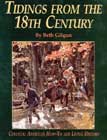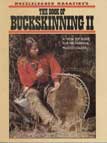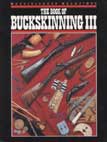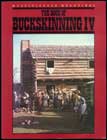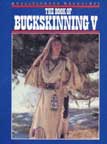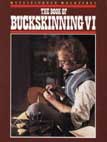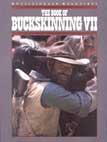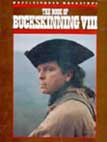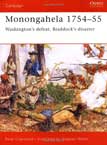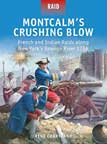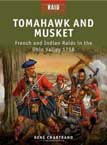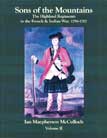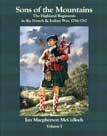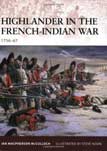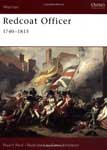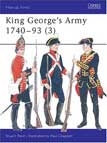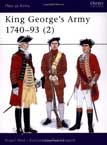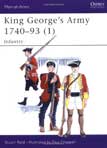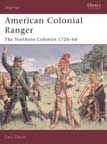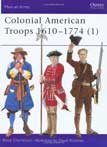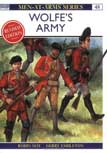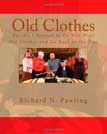

Beth Gilgun brings the mid to late 1700s to life with her entertaining and informative "letters" to a friend on the frontier. Great for reenactors, teachers, historic interpreters, and theatrical costumers. As an accomplished seamstress and goodwife, Gilgun shares with her "friend" information on clothing for men, women and children, as well as other topics of daily life in Colonial America. Included are clear, concise instructions for constructing reproduction 18th century garments, from choosing fabric to finishing. Her chatty letters include news about current events and the latest goods available on the East Coast.
*I met Beth Gilgun at a RevWar event once. I found her to be as neat in person as she seems in her books.
This book is a compilation of the first ten years of Mark Baker's column from Muzzleloader Magazine.
I don't know about you, but I have been a fan of Baker's for years... his ideas and articles are not only useful for his time-period, they also translate well to other time periods. Mark Baker truly IS one of the leading lights of "Experimental Archeology."
A Pilgrim's Journey contains over 300 pages of treks, scouts, hunts and how-to. Baker shares his knowledge and insights gained from wilderness experiences, extensive research, and from his partners and mentors along the way. Join Mark as he takes his pilgrim's journey back to the 18th century frontier. From flintlocks and moccasins to shooting bags and knapsacks, Baker explores the way of life of the Colonial woodsman. Learn about the clothing, accoutrements, food and skills from an era that helped forge the American Spirit and a new nation. Softcover. 306 pages with over 250 quality illustrations and photos, including many new photos in and updated layout.
Baker explores the longhunter's life in 18th century frontier America through the study of first-person accounts and hands-on research. In this second volume, Baker continues his pilgrim's journey to become an 18th century longhunter. Learn about the clothing, gear and food of the early American frontiersmen in his quest to discover the skills, lifestyle and mindset of those early woodsmen. Signed, limited edition hardcover with full-color dust jacket.
In-depth information on recreating life on the American frontier. Expand your enjoyment of living history with chapters including: Horseback Travel, Powder Horns, Canoeing, Camp Gear, Leather Clothing and Gun Tune-Up & Care. Each chapter was written by an experienced and knowledgeable participant in frontier reenacting. Lavishly illustrated with photographs and line drawings.
Explore recreating life on the American frontier. Solid information shared by knowledgeable and experienced reenactors help modern-day frontiersmen get started in the sport known as buckskinning. Subjects include: Historic Guns & Today's Makers, Quillworking, Trade Beads, 18th & 19th Century Cooking, The Hunting Pouch, Beadworking, Techniques for Making Footwear, and Period Shelters. Special color section of beadwork, quillwork, authentic frontier clothing, and trade bead photos
Enhance your frontier skills and knowledge. Each chapter was written by a knowledgeable and experienced participant in the sport known as buckskinning and lavishly illustrated with photos and drawings. Chapters include: Traditional Blacksmithing, Blankets in Early America, From Raw Hides to Rawhide, Styles of the Southwest, Smoothbores on the Frontier, Trade Silver, Backwoods Knives, Lighting the Primitive Camp, and Historic Sites & Museums. Emphasis is on demonstrating skills and how-to information.
Practical frontier American skills and knowledge are the focus in part five of this series on the sport known as buckskinning. Each chapter was written by a different author with in-depth knowledge of his or her topic. Chapters include: Fur Trade Indian Dresses; Old-Time Music & Instruments; Trade Goods for Rendezvous; Tipi Know-How; Engraving & Carving; Historic Sites & Museums II; Games, Sports & Other Amusements; and Pack Saddles & Panniers. Special color section features the dress of fur trade Indian women and horseback photos. Each chapter is abundantly illustrated with photos and drawings.
Hands-on frontier skills and in-depth historical information. Part six in this bestselling series on the pastime of recreating the American frontier, known as buckskinning, features more first-rate historical information and clear, hands-on instructions in the skills and crafts of the American pioneers. Chapters include: The Traditional Hunting Pouch, Horse Gear-East & West, Making a Wooden Bow, American Powder Horns, Frontier Trail Foods, Old-Time Shooting Matches, Period Trekking, and Finger Weaving. Special color section features photos of period horseback trips, powder horns, hunting pouches, and finger-woven sashes.
Best-selling guide to skills and crafts of frontier America. This book on the pastime of recreating the American frontier, known as buckskinning, continues the tradition of passing along accurate, practical information for the modern-day historian and reenactor. First-rate historical research and hands-on crafts include: Clothing of the Rocky Mountain Trapper, 1820-1840; Indian-Influenced Woodsmen of the Cane; Tools & Techniques of Bark Tanning; A Wardrobe for the Frontier Woman, 1780-1840; A Typical Day's Journey in Winter; Goods of the Trunk Maker & His Trade; Art & Writing on the Frontier; and Great Lakes & Eastern Woodlands Knife Sheaths. Includes a special color section featuring original art and artifacts plus reproductions. Each chapter was written by a knowledgeable participant in his field and is fully illustrated with photos and drawings.
Best-selling guide to skills and crafts of frontier America. Continuing the tradition with another in the bestselling series on the pastime of recreating the American frontier, known as buckskinning. Sound historical research and clear, understandable instructions in the crafts and skills of the American pioneers. Each chapter was written by an experienced participant and is lavishly illustrated. Chapters include: Gear of the Rocky Mountain Trapper, Beaver Hunting, Wing Shooting with a Flintlock Shotgun, History of the Horse in the Fur Trade, 18th Century Tatooing, The History & Trade Ledgers of Fort Hall, Independent Women of America's Past, Beadwork in the American West before 1850, and The Evolution of the Cocked Hat.
Osprey's examination of one of the key campaigns of the French and Indian War (1754-1763). On 9 July 1755 amid the wilderness of North America, Britain suffered one of the most humiliating defeats in her history. General Braddock’s army, a mixture of British regulars and American militia, was shattered, losing over 900 men from a force of 1,300. Braddock was killed and the remnants of his army rescued by his aide, Colonel George Washington. The origins of this defeat can be traced back to the death of a junior French officer little more than a year before in a relatively minor skirmish with a party of Virginian militia commanded by the same George Washington. René Chartrand examines the subsequent chain of events that ultimately sparked a world war.
With expert analysis and lively narrative, this engaging study of the Oswego raid casts light on a daring feat of arms at the height of the French and Indian War.
The year 1755 saw the rivalry between Britain and France in North America escalate along the Great Lakes into open warfare as both sides sought to overcome the other's forts and trading posts. Lord Loudoun and the Marquis de Montcalm were sent from the mother countries to take charge, but the French lost no time in seizing the initiative, adopting Canadian-style "wilderness" tactics and planning a series of raids to keep the enemy on their toes.
Amid the snows of March 1756, a 360-man French, Canadian, and Indian force stormed an Anglo-American outpost named Fort Bull in a surprise attack that left few survivors and the fort reduced to charred remains. Fort Bull's fall meant that the Mohawk River, the communication route between British-held Albany and the large and important Anglo-American post at Oswego, could now be cut off. Oswego, on the shore of Lake Ontario, had a formidable garrison based in three forts, named Pepperrell, George, and Ontario. The newly arrived Montcalm was tasked with the job of taking Oswego from the Anglo-Americans.
In July and August 1756, Montcalm's 3,000-strong force - including a full train of artillery, 80 pieces strong - was transported in hundreds of sailing ships and craft. The Anglo-Americans failed to spot the approaching French forces until they had landed and secured their positions. Having surrounded and invested the forts, the French soon knocked out of action a number of British guns. The British evacuated Fort Ontario and then, at 9am on August 14th, a French cannonball killed the British commander, Colonel James Mercer. His successor, Colonel John Littlehales, did not have the stuff of a hero; an hour later, the white flag went up and Oswego surrendered just in time to avert a major onslaught.
The Oswego raid was an outstanding French success; it denied the British a presence on Lake Ontario for the next two years, and relieved British pressure on Fort Frontenac. It demonstrated that the use of traditional European siege tactics in an American setting could reap great rewards, and had a great influence on the French's Indian allies too.
In 1758, at the height of the French and Indian War, British Brigadier General John Forbes led his army on a methodical advance against Fort Duquesene, French headquarters in the Ohio valley. As his army closed in upon the fort, he sent Major Grant of the 77th Highlanders and 850 men on a reconnaissance in force against the fort. The French, alerted to this move, launched their own counter-raid. 500 French and Canadians, backed by 500 Indian allies, ambushed the highlanders and sent them fleeing back to the main army. With the success of that operation, the French planned their own raid against the English encampment at Fort Ligonier less than fifty miles away. With only 600 men, against an enemy strength of 4,000, the French & Amerindians launched a daring night attack on the heart of the enemy encampment. This book tells the complete story of these ambitious raids and counter-raids, giving in-depth detail on the forces, terrain, and tactics.
Detailed essays on 18th-century uniforms, Highland weapons, specialist officers, and men (including pipers), as well as a comprehensive biographical index of all regimental officers (over 350 entries), who served in the three regiments--the 42nd (Black Watch), 77th (Montgomery's) and 78th (Fraser's) Highlanders--make this book the most complete and informative work on the history of the early Highland regiments of the British Army in North America during the French and Indian War to date.
Chronicles the stirring story of the three Highland regiments that soldiered in North America during the French and Indian War. The exploits of the 42nd (Black Watch), 77th (Montgomery's) and 78th (Fraser's) Highlanders, in some of the most bloody and desperate battles ever fought on the this continent, were a critical factor in transforming the overall image of Highlanders in the latter half of the 18th century from Jacobite rebels to Imperial heros.
Colonial American historian Ian Macpherson McCulloch uses rare sources to bring to life the stirring story of the three Scottish Highland regiments that operated in North America during the French-Indian War (1754-1763). Forbidden to carry arms or wear the kilt unless they served the British King, many former Jacobite rebels joined the new Highland regiments raised in North America. Involved in some of the most bloody and desperate battles fought on the North American continent, Highlanders successfully transformed their image from enemies of the crown to Imperial heroes. The author pays particular attention to the part they played at Ticonderoga, Sillery, Bushy Run and on the Plains of Abraham, Quebec.
The commissioned officer ranks in the British Army from 1740-1815 were almost entirely composed of the affluent and educated - the sons of the landed gentry, the wealthy, and other professional people. This title looks at the enlistment, training, daily life and combat experiences of the typical British officer in the crucial periods of the North American conflicts, the American Revolution, and the Napoleonic Wars. It compliments the author's previous treatments in Warrior 19 British Redcoat 1740-93 and Warrior 20 British Redcoat (2) 1793-1815, which deal exclusively with the common infantryman, and balances these discussions through a look at the 'fellows in silk stockings'. Particular emphasis is placed on the experiences and activities in North America in the late 18th century.
The 18th century was marked by a steady growth in central control of the British Army and a corresponding decrease in the influence enjoyed by individual commanding officers. The most obvious sign of this process was the increasing uniformity of the clothing issued each year to the soldiers. Nevertheless, as far as those who devised the Clothing Regulations were concerned, it was a constant, and invariably quite uphill struggle to enforce compliance. This companion volume to Men-at-Arms 285 and Men-at-Arms 289 examines the organization and uniforms of King George’s cavalry and artillery together with those of the Board of Ordnance.
The 18th century was marked by a steady growth in central control of the British Army and a corresponding decrease in the influence enjoyed by individual commanding officers. The most obvious sign of this process was the increasing uniformity of the clothing issued each year to the soldiers. Nevertheless, as far as those who devised the Clothing Regulations were concerned, it was a constant, and invariably quite uphill struggle to enforce compliance. This companion volume to Men-at-Arms 285 takes a further look at the infantry uniforms of the mid-18th century British Army, also covering the various auxiliary infantry formations, such as the Militia, Volunteers, Marines and the troops of the East India Company.
To most contemporary politicians the 18th century British Army was no more than an unwelcome necessity in wartime and an unjustifiable extravagance in peacetime. Nevertheless, the overall impression which is to be gained from a close study of the Army's own records, and from the surviving letters, diaries and memoirs, is that the British Army of the 18th century was very little different in character or in spirit from today's British Army. It was, above all, a force which was led, not driven, into battle. This book looks at the uniforms and organisation of the infantry of King George's Army as well as its participation in various conflicts, such as the War of the Austrian Succession (1740-1748) and the Seven Years' War (1756-1763).
This title examines the development of the Colonial Rangers in this period, and shows how they were taught to survive in the woods, to fight hand-to-hand, to scalp a fallen foe, and to fight across all types of terrain and in all weather conditions. Based on previously unpublished source material, it paints a vivid picture of the life, appearance and experiences of an American colonial ranger in the northern colonies. Covering the battle at Lovewell's Pond in 1725, a watershed event in New England’s frontier history, through to King George's War (1740-1748), the rangers were prepared for the final imperial contest for control of North America, the French-Indian War (1754-1763).
From the earliest English settlements the survival of the infant colonies in North America depended upon local militias. Throughout the 17th and early 18th centuries the burden of successive wars with the American Indians, and with the regular troops and militias of Britain's colonial rivals France and Spain, fell mainly upon locally raised volunteers. This first of a fascinating three-part study includes a general introduction and chronology, and chapters on Crown troops in North America; and begins a colony-by-colony review of militias and provincial units. The text is illustrated with rare early images and with eight specially commissioned full colour plates.
The British victory at Quebec in 1759 was a landmark in the history of North America. In this "year of miracles," according to Horace Walpole, one could "never afford to miss a single copy of a newspaper for fear of missing a British victory somewhere." Of all the pivotal figures in the Seven Years' War (1756-1763), a cast which included George Washington, Sir William Johnson, Lord Howe and Montcalm, Major-General Wolfe remains etched most deeply in Americans' memories for his heroic leadership at Quebec. Enhanced by illustrations and photographs, this book focuses on the British forces throughout their disastrous and triumphant wilderness campaigns which ultimately ensured the birth of the English-speaking United States of America.
This book is an indispensable guide to the often misunderstood field of living history. It presents the actuality that there is a great deal more involved in this discipline than merely “wearing old clothes and going back to the past.” This volume succinctly captures the perspectives that Richard Pawling has gained from over thirty-five years of experience in the interpretive profession (in county, state and national parks and as entrepreneur and owner of Rich Pawling’s History Alive!). Here, Pawling shares his observations and advice about everything from designing a living history persona to his successful use of this provocative teaching technique in the college classroom, to the role of research in helping you to learn about your own genealogical past. Though written for a broad audience, this book should be of particular interest to those employed as an interpretive park ranger or a naturalist, a museum or tour guide, or those who volunteer as a military reenactor or as a docent at a park, museum or historic site. Old Clothes presents the important lessons Pawling has learned along the way, the most important of which is that “life is a journey and understanding our past plays an important role in helping us to continue to learn not only about life in general, but more importantly, about ourselves.”
German King Heinrich IV petitions Pope Gregory VII for forgiveness
Philip II, Henry II and Richard Lion hearted initiate 3rd Crusade
Pierre de Tarantaise elected Pope Innocence V
Zen Buddhist religious debate between Tendai and Shingon
Head inquisitor Adrian Florisz Boeyens elected pope
Parliament passes bill of attainder against Queen Katherine Howard
Tsar Ivan IV defeats False Dmitri, who claims to be the true tsar
1st medical publication in America (pamphlet on smallpox), Boston
Russia and Persia sign Treaty of Riascha
Prussia and Russia sign partition treaty (Poland divided)
Pineapple introduced to Hawaii (or 01 / 111)
Paramaribo Suriname catches fire, 4 die
Ashantees defeat British at Accra, West Africa
Freedom Journal, 1st Black paper, begins publishing
Portsmouth (Ohio) blacks forcibly deported
Envelope-folding machine patented by Russell Hawes, Worcester, Massachusetts
Jefferson Davis of Mississippi and 4 other southern senators resign
City of Dublin leases part of Cattle Market for 100,000 years
1st US sewage disposal system separate from storm drains, Memphis
Amateur Athletic Union (AAU) forms
1st issue of Propria Cures, Amsterdam student-weekly newspaper
Oscar Fredriksen skates world record 500m in 47.8 seconds
"Wizard of Oz, " premieres in New York City
Harry Houdini escapes police station Halvemaansteeg in Amsterdam
International Theater (Majestic, Park) opens at 5 Columbus Circle New York City
Kenora Thistles sweep Mont Wanderers in 2 for Stanley Cup
New York City regulation makes it illegal for a woman to smoke in public
British-Russian military intervention in Persia
Aristide Briand forms French government
Kiwanis International founded in Detroit
Sinn Fein proclaims parliament of Free Ireland
Albanian parliament announces itself a Republic; Ahmed Zogoe President
Belgian parliament accepts Locarno treaties
1st national opera broadcast from a US opera house (Faust, Chicago)
USSR and Finland stop non-attack treaty
12.0" (30.5 cm) of rain falls, Quinault RS, Washington (state record)
WFI-AM in Philadelphia Penn merges with WLIT as WFIL (now WEAZ)
Wilderness Society forms
Dutch government starts obligatory unemployment insurance
US female Figure Skating championship won by Joan Tozzer
US male Figure Skating championship won by Robin Lee
Foreign correspondents in the Netherlands under censorship
1st anti-Jewish measures in Bulgaria
1st commercial extraction of magnesium from seawater, Freeport, Texas
Australia and Britain attack Tobruk Libya
British communist newspaper "Daily Worker" banned
Bronx magistrate rules all pinball machines illegal
Soviet forces reconquer Gumrak airport near Stalingrad
Soviet forces reconquer Worosjilowsk
Vice-admiral Cunningham appointed British Admiral of the Fleet
447 German bombers attack London
649 British bombers attack Magdeburg
British troops land on Ramree, near coast of Burma
"Nellie Bly" opens at Adelphi Theater NYC for 16 performances
"Sweethearts" opens at Shubert Theater NYC for 288 performances
West Indies vs. England, Test debut Walcott, Weekes and Jim Laker
1st inaugural parade televised (Harry Truman)
"Lend an Ear" closes at National Theater NYC after 460 performances
New York jury finds former State Department official Alger Hiss guilty of perjury
John Foster Dulles appointed as Secretary of State
1st gas turbine automobile exhibited (NYC)
"Comedy in Music (Victor Borge)" closes at Golden NYC after 849 performances
William Shawn succeeds Harold Ross as editor of New Yorker
KSAT TV channel 12 in San Antonio, TX (ABC) begins broadcasting
KMOT TV channel 10 in Minot, ND (NBC) begins broadcasting
Little Joe 4 suborbital Mercury test reaches 16 km
Rock falls traps 437 at Coalbrook South Africa, 417 die of methane poisoning
"Conquering Hero" closes at ANTA Theater NYC after 8 performances
KIFI TV channel 8 in Idaho Falls, ID (NBC) begins broadcasting
Portuguese rebels seize cruise ship Santa Maria
JFK arrives in Uruguay
Snow falls in San Francisco
Carl T Rowan named Director of US Information Agency
Persians Premier Ali Mansoer injured
Beatle George Harrison marries model Patti Boyd
AFL Pro Bowl: East beats West 30-23
US female Figure Skating championship won by Peggy Fleming
US male Figure Skating championship won by Gary Visconti
AFL Pro Bowl: East beats West 25-24
NFL Pro Bowl: West beats East 38-20
US B-52 bombers with nuclear bomb crashes in Greenland
22nd NHL All-Star Game: West beat East 3-3 at Montreal
Panama Boeing 747 1st flight NY-London
"Alias Smith & Jones" premieres on ABC TV
Belgium government of Eyskens-Cools forms
Manipur, Meghalaya and Tripura become separate states of Indian union
Mizoram, formerly part of Assam, creates an Indian union territory
3rd NFL Pro Bowl: AFC beats NFC 33-28
Leslie Nielson appears on M*A*S*H in "Ringbanger"
Gold hits record $161.31 / silver hits record $3.97 an ounce in London
28th NHL All-Star Game: Wales beat Campbell 7-1 at Montreal
Supersonic Concorde, 1st commercial flights, by Britain and France
President Jimmy Carter pardons almost all Vietnam War draft evaders
Neptune becomes outermost planet (Pluto moves closer)
Price of gold increases to record $875 troy oz
Super Bowl XIII: Pittsburgh Steelers beat Dallas Cowboys, 35-31 in Miami Super Bowl MVP: Terry Bradshaw, Pittsburgh, QB
Gold hits record $850 an ounce
Bernhard Goetz is assault for 1st time on a New York subway train
New York Islanders begin then NHL record 15 game winning streak
Bollingen Prize for poetry awarded to Anthony E Hecht
Reagan certifies El Salvador human-rights abuses have decreased making country eligible for US military aid
US male Figure Skating championship won by Scott Hamilton
Bomb attack on Borobudur temple in Java
Allison J Brown, 17, of Oklahoma, crowned 4th Miss Teen USA
Bomb attack in East-Beirut, 27 killed
BB King donates his 7,000 record collection to University of Mississippi
US accept immigration of 30,000 US-Vietnamese children
A woman is assaulted and raped in room of an Okla football player
41st NHL All-Star Game: Wales beat Campbell 12-7 at Pittsburgh
Bob Goodenow succeeds Alan Eagleson as NHL Players Association Executive Director
John McEnroe becomes 1st ever expelled from Australian Open; for
Patty Sheehan wins LPGA Jamaica Golf Classic
CBS News correspondant Bob Simon captured by Iraqis in Persian Gulf
Nigerian singer Fela Kuti arrested on suspicion of murder
Dow Jones passes 3900 (record 3,914.20)
52th Golden Globes: Forrest Gump, Tom Hanks, Jessica Lange
53th Golden Globes: Mel Gibson, Nicole Kidman, John Travolta
Karrie Webb wins LPGA HealthSouth Inaugural Golf Tournament
US male Figure Skating championship won by Rudy Galindo
Pope John Paul II visits Cuba
